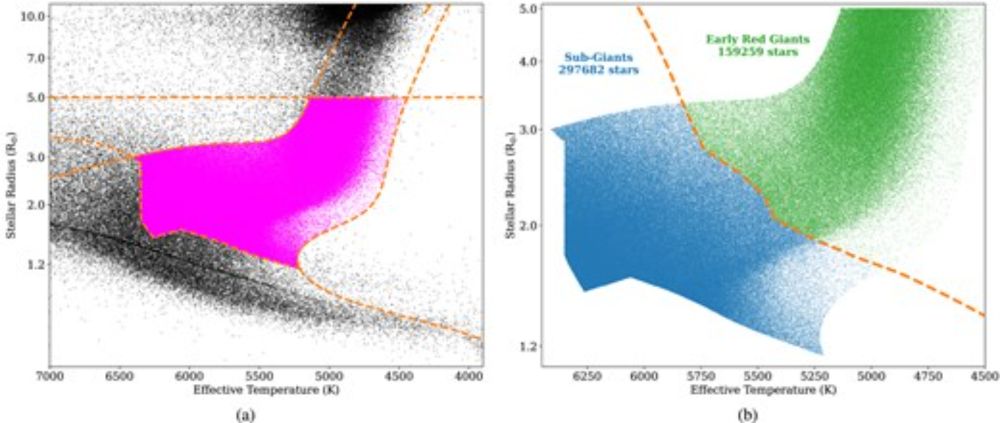In their previous paper, they suggest that it might be a mass difference that creates the progenitor age bias, but they can't rule out composition.
academic.oup.com/mnras/articl...
academic.oup.com/mnras/articl...
November 6, 2025 at 12:13 PM
Everybody can reply
1 likes
Published in #MNRAS: "Visual morphological classification of the full MaNGA DR17 sample: a general characterization", Vázquez-Mata et al. This are Figs. 1 & 2: for the caption & to read the paper please visit academic.oup.com/mnras/articl... @royalastrosoc.bsky.social @oxfordacademic.bsky.social


November 6, 2025 at 9:32 AM
Everybody can reply
3 likes
again, the big bang being a white hole that inherited it's parent black hole's angular momentum - causing the universe to slowly rotate - fits so many of our observations and solves one of the major issues in current cosmology
academic.oup.com/mnras/articl...
academic.oup.com/mnras/articl...
November 6, 2025 at 1:34 AM
Everybody can reply
3 reposts
9 likes
There are methods to estimate comet masses from non-gravitational accelerations; but that requires measuring the ejecta mass-velocity distribution.
For one older reference: academic.oup.com/mnras/articl....
For one older reference: academic.oup.com/mnras/articl....

Cometary masses derived from non-gravitational forces
Abstract. We compute masses and densities for 10 periodic comets with known sizes: 1P/Halley, 2P/Encke, 6P/d'Arrest, 9P/Tempel 1, 10P/Tempel 2, 19P/Borrell
academic.oup.com
November 5, 2025 at 8:45 PM
Everybody can reply
3 likes
Bryant & Van Eylan identify 130 short period planets and candidates, of which 33 are newly discovered candidates, from a sample of 456,941 post main sequence stars. Read the #MNRAS paper to find out more academic.oup.com/mnras/advanc... (this is Fig. 3) @royalastrosoc.bsky.social

November 5, 2025 at 4:49 PM
Everybody can reply
1 likes
Published in #MNRAS: "Determining the impact of post-main-sequence stellar evolution on the transiting giant planet population", by Bryant & Van Eylen academic.oup.com/mnras/advanc... describes the use of TESS data to search for post-main-sequence hosts.

Determining the impact of post-main-sequence stellar evolution on the transiting giant planet population
ABSTRACT. The post-main-sequence evolution of stars is expected to impact the exoplanets residing on close-in orbits around them. Using photometric data fr
academic.oup.com
November 5, 2025 at 4:49 PM
Everybody can reply
1 likes
also this paper relating NGA to outgassing/brightness. I'd have to check the numbers but I'm pretty sure both are within the normal kind of range for 3I academic.oup.com/mnras/articl...

Masses of long-period comets derived from non-gravitational effects – analysis of the computed results and the consistency and reliability of the non-gravitational parameters
Abstract. We estimate masses for a selected sample of long-period comets (LPCs) (with orbital periods P > 1000 yr and perihelion distances q < 2 au),
academic.oup.com
November 5, 2025 at 4:28 PM
Everybody can reply
5 likes
1 saves
Determining the impact of post-main-sequence stellar evolution on the transiting giant planet population: academic.oup.com/mnras/advanc... -> Ageing stars may be destroying their closest planets: ras.ac.uk/news-and-pre...

Determining the impact of post-main-sequence stellar evolution on the transiting giant planet population
ABSTRACT. The post-main-sequence evolution of stars is expected to impact the exoplanets residing on close-in orbits around them. Using photometric data fr
academic.oup.com
November 5, 2025 at 3:43 PM
Everybody can reply
1 likes
The ageing of host stars can be catastrophic for planets!
Our new research into this planet population shows that the evolution of stars causes giant planets to spiral into their host stars and be destroyed.
Check out the press release below and paper (published in MNRAS today!) for more
Our new research into this planet population shows that the evolution of stars causes giant planets to spiral into their host stars and be destroyed.
Check out the press release below and paper (published in MNRAS today!) for more
🚨New research alert🚨
Ever wondered what might happen to Earth and the other planets in our solar system when the Sun becomes a red giant in 5 billion years? ☀️🔴
Ever wondered what might happen to Earth and the other planets in our solar system when the Sun becomes a red giant in 5 billion years? ☀️🔴
November 5, 2025 at 3:17 PM
Everybody can reply
4 reposts
10 likes
A new model explains the chemical mysteries of globular #clusters! 💡
These groups of #stars contain elements in abundances that had defied any explanation 🤔
#IEEC researchers at the @icc-ub.bsky.social have led this work.
@ub.edu @icreacommunity.bsky.social #MNRAS
👉 www.ieec.cat/en/extremely...
These groups of #stars contain elements in abundances that had defied any explanation 🤔
#IEEC researchers at the @icc-ub.bsky.social have led this work.
@ub.edu @icreacommunity.bsky.social #MNRAS
👉 www.ieec.cat/en/extremely...

November 5, 2025 at 2:56 PM
Everybody can reply
1 reposts
6 likes
Published in #MNRAS: "Co-existence of slow magnetoacoustic waves and thermal limit cycles in a coronal bright point", Matsumoto et al. This is Fig. 1: for the caption & to read the paper please visit academic.oup.com/mnras/articl... @royalastrosoc.bsky.social @oxfordacademic.bsky.social

November 5, 2025 at 9:49 AM
Everybody can reply
2 likes
This paper also features in this press release from the University of Barcelona, "Extremely massive stars forged the oldest star clusters in the universe": web.ub.edu/en/web/actua... . #MNRAS

November 4, 2025 at 5:12 PM
Everybody can reply
2 likes
Published in #MNRAS: "Globular cluster formation from inertial inflows: accreting extremely massive stars as the origin of abundance anomalies", Gieles et al. This is Fig. 4: read the paper here academic.oup.com/mnras/articl... @oxfordacademic.bsky.social @royalastrosoc.bsky.social

November 4, 2025 at 5:12 PM
Everybody can reply
4 likes
🔵#News | Results show that giant stars can shape ancient star clusters!
✨Their chemical fingerprints on the Universe's oldest star clusters help explain so-far puzzling observations
👏#ICREA #ICCUB @ieec.cat researcher Mark Gieles led the study published in #MNRAS
🔗 https://bit.ly/4ogrv7h @ub.edu
✨Their chemical fingerprints on the Universe's oldest star clusters help explain so-far puzzling observations
👏#ICREA #ICCUB @ieec.cat researcher Mark Gieles led the study published in #MNRAS
🔗 https://bit.ly/4ogrv7h @ub.edu

November 4, 2025 at 10:02 AM
Everybody can reply
3 reposts
5 likes
Published in #MNRAS: "The influence of the accretion disc structure on X-ray spectral states in symbiotic binaries", Toalá & Vasquez-Torres. This is Fig. 5: for the caption & to read the paper please visit academic.oup.com/mnras/articl...

November 4, 2025 at 9:50 AM
Everybody can reply
4 likes
Published in #MNRAS: "The ALPINE–CRISTAL–JWST survey: revealing less massive black holes in high-redshift galaxies", Ren et al. This is Fig. 1: for the caption & to read the paper please visit academic.oup.com/mnras/articl... @royalastrosoc.bsky.social @oxfordacademic.bsky.social

November 3, 2025 at 8:24 AM
Everybody can reply
6 likes
In a follow-up paper, the authors also found that biofluorescence could be useful around cooler red dwarf stars that have ultraviolet “flares"—high-energy bursts that life would need to protect itself from.
Paper 1: academic.oup.com/mnras/articl...
Follow-up: academic.oup.com/mnras/articl...
Paper 1: academic.oup.com/mnras/articl...
Follow-up: academic.oup.com/mnras/articl...

October 31, 2025 at 6:14 PM
Everybody can reply
1 reposts
3 likes
Published in #MNRAS: "Ion-neutral chemistry at icy moons: the case of Ganymede", Beth et al. This is Fig. 2: for the caption & to read the paper please visit academic.oup.com/mnras/articl... @royalastrosoc.bsky.social @oxfordacademic.bsky.social

October 31, 2025 at 8:28 AM
Everybody can reply
1 reposts
5 likes
1 saves
Scientists are exploring this with studies like "Exploring the expanding universe and dark energy using the Statefinder diagnostic" found at https://academic.oup.com/mnras/article-abstract/344/4/1057/969326 They analyze different models to decode dark energy's nature.
October 31, 2025 at 5:32 AM
Everybody can reply
Today on the arXiv and submitted to MNRAS:
Yaginuma et al. 2025, "Potential Thermal Profiles of The Third Interstellar Object 3I/ATLAS" - arxiv.org/abs/2510.25945
Suggesting an albedo for the comet's nucleus of < 0.2, which would be right in the middle of the range for solar system comets.
Yaginuma et al. 2025, "Potential Thermal Profiles of The Third Interstellar Object 3I/ATLAS" - arxiv.org/abs/2510.25945
Suggesting an albedo for the comet's nucleus of < 0.2, which would be right in the middle of the range for solar system comets.

Potential Thermal Profiles of The Third Interstellar Object 3I/ATLAS
We investigate the thermal evolution of 3I/ATLAS, the third macroscopic interstellar object discovered on 2025 July 1. By comparing modeled thermal profiles with observations of volatile activity, it ...
arxiv.org
October 31, 2025 at 2:17 AM
Everybody can reply
1 likes
Delighted to announce that the first paper of my PhD - "The role of magnetic fields in ram pressure stripping of satellite galaxies in the circumgalactic medium around massive galaxies" - has been published by MNRAS!
Check out the paper here: academic.oup.com/mnras/articl...
🧪🔭
Check out the paper here: academic.oup.com/mnras/articl...
🧪🔭

October 30, 2025 at 2:25 PM
Everybody can reply
1 reposts
4 likes
Published in #MNRAS: "The tidal evolution of anisotropic subhaloes: a new pathway to creating isotropic and cored satellites", Chiang et al. This is Fig. 2: to read the paper please visit academic.oup.com/mnras/articl... @oxfordacademic.bsky.social @royalastrosoc.bsky.social

October 30, 2025 at 8:33 AM
Everybody can reply
1 reposts
2 likes
New in the #VirtualObservatory: “WASP-4 mid-transit times” by Basturk O. et al.
https://cdsarc.cds.unistra.fr/viz-bin/cat/J/MNRAS/541/714
#visibleastronomy #exoplanets #photometry #multiplestars
https://cdsarc.cds.unistra.fr/viz-bin/cat/J/MNRAS/541/714
#visibleastronomy #exoplanets #photometry #multiplestars
VizieR J/MNRAS/541/714
cdsarc.cds.unistra.fr
October 30, 2025 at 6:57 AM
Everybody can reply
1 likes
Today on the arXiv and accepted at MNRAS: Ward & Ćuk 2025, "On The Applicability of Ring-Moon Cycles to Exoplanets" - https:// arxiv.org/abs/2510.24644 Based on Isabella Ward's work as part of the @ setiinstitute REU program.
Interest | Match | Feed
Interest | Match | Feed
Origin
mastodon.online
October 29, 2025 at 7:25 PM
Everybody can reply
1 likes
Today on the arXiv and accepted at MNRAS:
Ward & Ćuk 2025, "On The Applicability of Ring-Moon Cycles to Exoplanets" - arxiv.org/abs/2510.24644
Based on Isabella Ward's work as part of the @setiinstitute.bsky.social REU program.
Ward & Ćuk 2025, "On The Applicability of Ring-Moon Cycles to Exoplanets" - arxiv.org/abs/2510.24644
Based on Isabella Ward's work as part of the @setiinstitute.bsky.social REU program.

On The Applicability of Ring-Moon Cycles to Exoplanets
The presence of rings and moons around exoplanets is likely to be one of the next great discoveries in exoplanet research. Using theories developed for the Solar System, we explore the possibility of ...
arxiv.org
October 29, 2025 at 7:24 PM
Everybody can reply
1 reposts
1 quotes
15 likes

